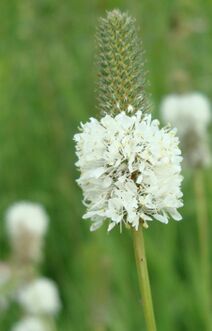Dalea candida
| Dalea candida | |
 | |
| Light: | |
| Moisture: | |
| Soil pH: | 5.6-8.4 |
| Height: | 2' |
| Blooms: | Mid Summer-Late Summer |
| Native to: | |
| Nitrogen Fixer Nectary | |
| Edible Rating: | |
| Medicinal Rating: | |
| Tea: | Yes |
Dalea candida (common name: white prairie clover)
Dazzling white blossoms start at the base of short spikes and proceed upwards as the season progresses. This clover is a larval host plant for dogface butterfly, an important browse source for antelope, deer, and grouse, and a palatable and nutritious forage for livestock. Native Americans also chewed the roots for a pleasant sweet treat and made tea with dried leaves. A central taproot grows up to 6’ deep and that plant grows best in sandy, gravely and silty soils. The seeds fall short distances from the plant when the wind blows and does not spread aggressively. Inoculate seeds with a proper Rhizobium strain prior to sowing for maximum nitrogen fixation from this legume. Easily distinguish between purple and white prairie clover before flowering by examining the leaves: narrow on purple, wide on white.
Propagation: Seed - pre-soak for 12 hours in warm water and sow in early spring in a greenhouse. When they are large enough to handle, prick the seedlings out into individual pots and plant them out into their permanent positions in the summer[1].
Cultivation: Requires a well-drained soil in full sun[1]. A deep-rooted plant, it prefers a sandy loam with added leaf mould[2]. This species is well-suited to informal and naturalistic plantings, especially as part of a collection of native species[1].
We are not sure how hardy this plant is in Britain, but judging by its native range it should succeed outdoors in many parts of the country.
Plants are monocarpic, living for a number of years without flowering and then dying after flowering[1].
The stems, leaves and flowers are dotted with glands, making the plant look blistered[1].
This species has a symbiotic relationship with certain soil bacteria, these bacteria form nodules on the roots and fix atmospheric nitrogen. Some of this nitrogen is utilized by the growing plant but some can also be used by other plants growing nearby[1].
Range: Central N. America - southwards from Canada.
Habitat: Dry desert and alluvial soils to 2000 metres[3][1]. Prairies and open wods on sandy, clayey and rocky soils[4].
Edibility: Root - raw or chewed for its pleasant sweet flavour[5][6][7][8]. Eaten as a delicacy by children[9].
A tea-like beverage is made from the dried leaves[5][6][7][8].
Medicinal: The roots have been chewed to bring relief from the pain of toothaches etc[9].
Soil: Can grow in light and medium soils.
Drainage: Prefers well drained soil.
Flower Type: Hermaphrodite
Also Known As: Petalostemon candidum. (Willd.)Michx.
Links
References
- ↑ 1.0 1.1 1.2 1.3 1.4 1.5 1.6 Huxley, Anthony. The New Royal Horticultural Society Dictionary of Gardening. MacMillan Press, 1992.
- ↑ Chittendon, Fred. RHS Dictionary of Plants. Oxford University Press, 1951.
- ↑ Lyndon, Merritt. Gray's Manual of Botany. American Book Co, 1950.
- ↑ Diggs, George and Barney Lipscomb. Illustrated Flora of North Central Texas. Botanical Research Institute, 1999.
- ↑ 5.0 5.1 Tanaka, Tyōzaburō. Tanaka's Cyclopaedia of Edible Plants of the World. Keigaku Publishing, 1976.
- ↑ 6.0 6.1 Yanovsky, Elias. Food Plants of the North American Indians Publication 237. US Department of Agriculture.
- ↑ 7.0 7.1 Kunkel, Günther. Plants for Human Consumption. Koeltz Scientific Books, 1984.
- ↑ 8.0 8.1 Facciola, Stephen. Cornucopia - A Source Book of Edible Plants. Kampong Publications, 1990.
- ↑ 9.0 9.1 Moerman, Daniel. Native American Ethnobotany. Timber Press, 1998.